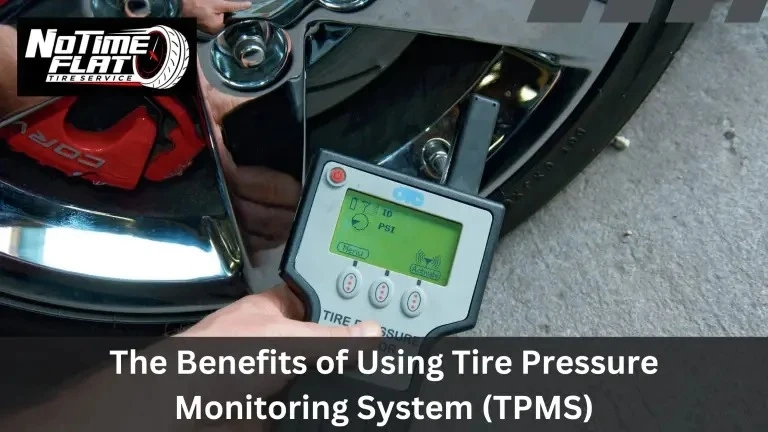Today, keeping our vehicles safe and running smoothly is more important than ever. It\'s not just about the powerful engines or reliable brakes, but also the often overlooked heroes that keep us rolling - our tires. That\'s where the Tire Pressure Monitoring System (TPMS) comes in. This innovative technology acts as a watchful protector, ensuring that your tires are always safe and performing at their best.
In this blog post, we\'ll learn about TPMS, understand why it\'s a must-have for every vehicle owner, and find the secrets to maintaining it for long-lasting benefits. Be ready to acknowledge the key to a safer and more efficient driving experience!
What is TPMS?
TPMS, short for Tire Pressure Monitoring System, is an electronic system that monitors the air pressure inside your tires. With its real-time reporting, TPMS informs you about the air pressure inside your tires, whether through a gauge, a visual pictogram display, or a low-pressure warning light. No more risks of underinflated or overinflated tires, just hello to a smoother, safer ride.
What Should You Do if Your TPMS Warning Light is On?
When your TPMS warning light shows on while you see the dashboard, it signals that one or more of your tires are underinflated, impacting vehicle handling, fuel efficiency, and safety. Here\'s what to do: safely pull over and visually inspect your tires for damage or deflation.
Use a tire pressure gauge to check the air pressure in all four tires, comparing the readings to recommended levels in the owner\'s manual or on the driver\'s side door jamb. If a tire is low, inflate it to the specified pressure (keep a mobile inflator for emergencies). Without a gauge or air pump, drive carefully to the nearest service station.
Inflate the tires correctly, and the TPMS light should turn off after driving a few miles. If the light persists or tire pressure issues arise, consult a mechanic to rule out leaks or sensor malfunctions. Regular maintenance and prompt TPMS response ensure prolonged tire life and safe driving.
The Benefits of Using Tire Pressure Monitoring System (TPMS)
Learn the advantages of having a Tire Pressure Monitoring System (TPMS) in your vehicle.
Stay Informed About Your Tires: Get constant updates about your tire condition as you drive, thanks to your TPMS. It provides essential information to help you drive safely and efficiently.
Know When Your Tires Are Low: Your TPMS notifies you when your tires have low pressure. It allows you to take action and maintain proper tire pressure for better vehicle performance and fuel efficiency.
Detect Leaks and Punctures: If your TPMS light comes on immediately after filling your tires, it could indicate a loose seal or a tire leak. Your TPMS can alert you to slow leaks or punctures, preventing pressure loss and the need for tire repair services.
Improve Safety: Proper tire pressure is vital for safe driving. A TPMS helps you keep your tires correctly inflated, reducing the risk of tire failures like blowouts and flats. It also improves road grip and handling, ensuring a safer driving experience.
Improve Fuel Efficiency: You can improve your tires\' fuel efficiency by keeping your car\'s tires at the optimal pressure levels. Properly inflated tires offer the right balance of resistance and performance, allowing your car to go further with less fuel consumption.
Extend Tire Life: Maintaining optimal tire pressure promotes even wear and tear while extending the life of your tires. It reduces the frequency of tire replacements and saves you money in the long run.
Optimize Performance: Properly inflated tires optimize your vehicle\'s performance. Well-maintained tires with the right pressure improve braking, handling, and overall driving experience. Your TPMS helps you achieve optimal tire pressure for top performance.
Maintenance Requirements for TPMS:
Make sure the effectiveness of your TPMS by following these maintenance tips:
Regular Checks and Calibration: Make sure your TPMS is calibrated as per the manufacturer\'s specifications. It is typically done during regular vehicle servicing to keep your system accurate and reliable.
Sensor Battery Life: Direct TPMS sensors have batteries that last around 5 to 10 years. Keep track of their lifespan and replace them when needed to ensure continuous monitoring of tire pressure.
Visual Inspections: You must regularly inspect your tires for any signs of damage or wear that may not be detected by the TPMS, especially if you have an indirect system. It helps identify potential issues and maintain tire health.
Seasonal Adjustments: Be mindful of temperature changes that can impact tire pressure. During extreme seasons or major temperature shifts, check and adjust your tire pressures accordingly to ensure optimal performance
Tire Pressure Monitoring System Sensor Replacement
Maintaining the effectiveness of your TPMS by replacing sensors is necessary.
Reasons for Replacement
Your TPMS sensors may need replacement due to battery depletion (typically after 5-10 years), sensor malfunction, or physical damage. Functional sensors are required for accurate tire pressure monitoring, which ensures vehicle safety and performance.
Steps to Replace TPMS Sensors
- Preparation: Gather tools such as a tire jack, lug wrench, valve stem tool, and replacement TPMS sensors. Park your car\'s vehicle on a flat, stable surface.
- Remove the Tire: Loosen the lug nuts, lift the vehicle using a tire jack, and thoroughly remove the lug nuts. Take the tire off.
- Deflate the Tire: Use a valve stem tool to release the air from the tire by removing the valve core.
- Remove the Old Sensor: Partially detach the tire from the rim to access the TPMS sensor. Unscrew and remove the old sensor from the valve stem.
- Install the New Sensor: Place the new TPMS sensor into the valve stem hole and securely fasten it. Provide a tight fit to prevent air leaks.
- Reassemble the Tire: Re-seat the tire onto the rim, inflate it to the recommended pressure, and reattach it to the vehicle. Tighten the lug nuts securely.
Note: If one sensor needs replacing, it\'s recommended that all sensors be replaced at the same time. Consult your vehicle\'s manual or take professional assistance from tire pressure monitoring service providers for specific instructions and help on TPMS sensor replacement.
The Procedure for TPMS Relearning
Ensure your vehicle\'s TPMS recognizes and communicates with new sensors through the relearning process.
Relearning Methods
Manual Relearn: Some vehicles offer a manual reset procedure. It involves specific steps like turning the ignition on and off, pressing buttons, or driving at a specified speed for a certain period.
OBDII Relearn: Technicians can use an OBDII tool to program the new TPMS sensors directly into the vehicle\'s computer system. This method ensures precise synchronization and is often faster.
Trigger Tool Relearn: Professionals may use specialized TPMS trigger tools to activate the sensors and send their information to the vehicle\'s computer. This method offers accuracy and efficiency.
General Steps for Relearning
Start the Vehicle: Turn the ignition to the "On" position without starting the engine.
Activate the Sensors: Use a tire pressure monitoring system tool to activate each sensor by holding it near the valve stem and following the tool\'s instructions.
Follow the Vehicle\'s Relearn Procedure: This varies by manufacturer but generally involves a combination of ignition cycles, button presses, or driving the vehicle.
Verify: Ensure the TPMS light turns off and the system reads the correct tire pressures, indicating successful relearning.
Remember to consult your vehicle\'s manual or seek professional guidance from a tire pressure monitoring service provider for specific TPMS relearning procedures for your vehicle model.
Prioritize Safety and Peace of Mind with TPMS!
A Tire Pressure Monitoring System (TPMS) is not just a convenient tool; it is an essential component of your vehicle that prioritizes safety, improves performance, and provides peace of mind. By understanding how TPMS works and following simple maintenance practices, you can ensure that this system serves you well throughout your vehicle\'s lifespan.
Remember, the safety of the roads we travel depends on the care we take with our vehicles. Regularly checking your TPMS allows for a smooth and worry-free ride while keeping yourself, your passengers, and other drivers safe. Trust skilled tire services providers proficient in recalibrating and repairing your TPMS to ensure efficient and precise operation.



